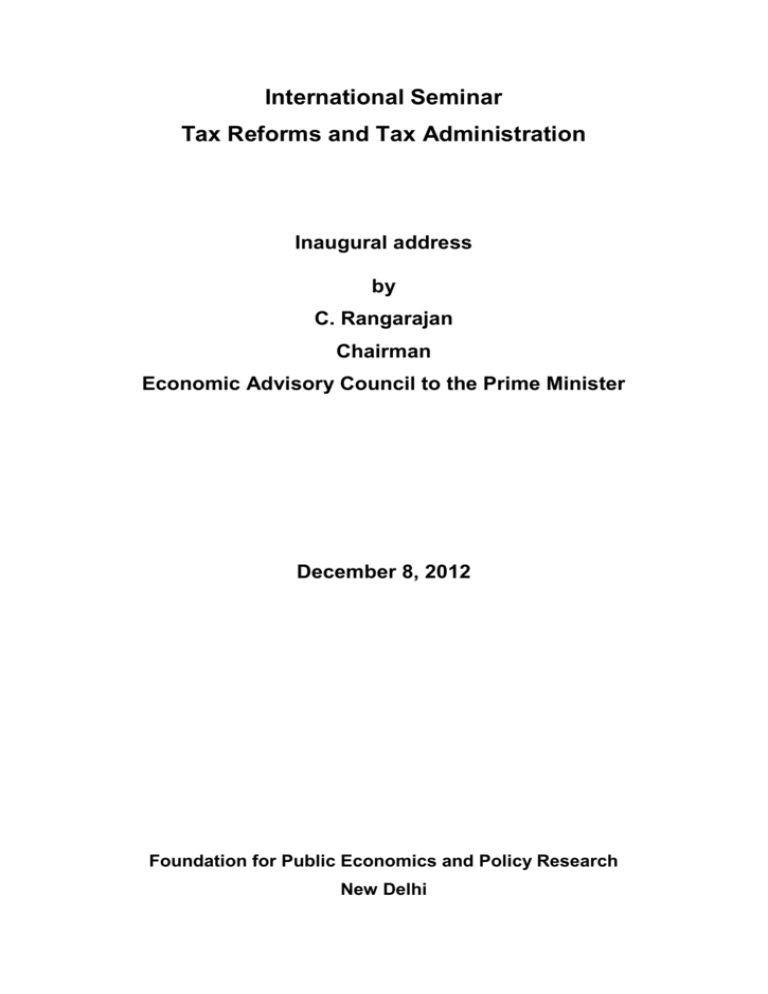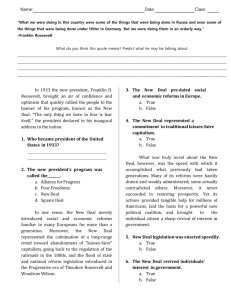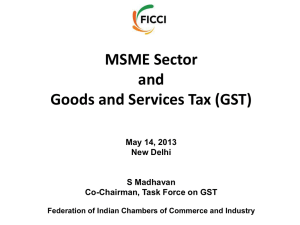Tax Reforms and Tax Administration
advertisement

International Seminar Tax Reforms and Tax Administration Inaugural address by C. Rangarajan Chairman Economic Advisory Council to the Prime Minister December 8, 2012 Foundation for Public Economics and Policy Research New Delhi Tax Reforms and Tax Administration by C. Rangarajan Chairman Economic Advisory Council to the Prime Minister I am indeed happy to be in your midst this morning and to inaugurate this Seminar on Tax Reforms and Tax Administration in India organized by the Foundation for Public Economics and Policy Research. I am all the more happy to note that this seminar is being organized to commemorate the tenth anniversary of this Institute. At the outset, I congratulate the Director and the staff of the Foundation on this special occasion. I have looked at the progress report of the Institute and 2 am very happy to note that they have done very well during the first decade of their existence. The theme of this Seminar is vital given the wide range of tax reforms that have been initiated in India since 1990s and continue to remain on the forefront of the reforms agenda even today. The tax reforms of the nineties set the stage for achieving a higher tax-GDP ratio and this has helped the country to achieve a higher level of growth. It has focussed mainly on simplification and rationalization of the rate structure; reduction in the high marginal rates and the rate categories; reducing dispersion in the tax rates; and lowering tax rates. Efforts have also been made to rationalize the structure and scope of tax incentives. The thrust has been on broadening the tax base; improving the tax administration; and 3 promoting fairness in the tax system to check adverse effects on efficiency and neutrality. To begin with, a wide range of reform measures were undertaken on the basis of the recommendations of Tax Reforms Committee headed by Dr. Raja Chelliah. As a consequence, attempts were made to moderate tax rates, widen tax base, provide necessary tax incentives for development of infrastructure and housing, and strengthen tax enforcement. In the case of indirect taxes, steps were taken to reduce multiplicity of rates, rationalization of the rate structure, and adoption VAT procedure in union excise duty and sales tax. Kelkar Task Force on Direct and Indirect Taxes, and Shome Committee on Tax Policy and Tax Administration for the Tenth Plan, have highlighted that the factors responsible for low tax-GDP ratio 4 relate to structure as well as to the administration of the taxes. While it is recognized that the key to restoration of fiscal health lies in attaining the appropriate tax-GDP ratio, the path has not yet been smooth. After having risen sharply, in the recent period, there has been a decline in this ratio which needs to be reversed. Owing to plethora of changes in the original enactment of the taxes on income and property, their structure has become very complex. The situation has led not only to high administrative and compliance costs but also significant distortions in resource allocation. While efforts have been made to lower the marginal rate and rationalize the structure, it is felt that the strategy for broadening the base essentially comprises of two elements. The first is to minimize exemptions. The removal of these exemptions will have three consequences: (i) it will result in a higher 5 tax-GDP ratio; (ii) it will enhance GDP growth, since tax exemptions and deductions distort allocative efficiency; and (iii) it will improve equity (both horizontal and vertical), reduce compliance costs, lower administrative corruption. The burdens, second and problem is discourage related to ambiguity in the law, which facilitates tax avoidance. Efforts have, therefore, been made to redraft the overall income tax Act. The revised enactment known as Direct Taxes Code (DTC) has already been approved by the cabinet in August 2010 and is before the Parliament. The DTC would be a new law replacing the existing income tax Act so as to establish an economically efficient, effective and equitable direct tax system which will facilitate voluntary compliance and reduce the scope for disputes and minimize litigation. It would be expressed in simple language; 6 avoid ambiguity in the provisions that invariably give rise to rival interpretations; would be capable of accommodating the changes in the structure of a growing economy without resorting to frequent amendments; and would consolidate provisions relating to definitions, incentives, procedures etc. It would be based on well accepted principles of taxation and best international practices. Though the fiscal reforms at the Central level commenced at the beginning of the nineties, the States have moved strongly only in the last decade. State-level reforms are, however, critical for accelerating growth in the country. Reforms at State level took place in various forms such as proposals relating to new tax and nontax measures aimed at strengthening the revenue 7 base. Path breaking reform in State taxes was the replacement of sales tax by State Value Added Tax. The introduction of dual-VAT in India has been a remarkable achievement in reforming the system of commodity taxes both at the Centre and the State levels. It helped remove cascading to some extent and make business competitive. However, this was only an intermediate step as the introduction of a dual-VAT did not take care of all the deficiencies in the system. Recognizing this, it is now proposed to introduce GST to replace the existing dual-VAT, service tax and some other commodity taxes levied by both the Centre and State Governments. Most of the arguments in favour of introduction of the proposed goods and services tax(GST) in India are centred around providing an expanded tax base to 8 both the Union and state governments so that there can emerge a stable tax regime with reliable revenues. From what is known about the GST regime, in terms of design, it is clear that the proposed regime would involve two taxes, a central GST and a State GST. Alongside, it is proposed that all inter-state transactions will be taxed through a destination based levy called IGST. These taxes would cover all goods and services, except those explicitly exempted as in the negative list for services. The rates of tax are still not announced, but it is proposed that there would be two rates for goods and one rate of tax applicable for services. There are no decisions yet on the exemption threshold for the tax, which is an important and critical decision in order to understand the impact of the proposed tax on the tax payers. 9 In this context considerable efforts have also been made both by the Centre and State Governments to create an appropriate institutional structure for implementation. Major thrust has been on creating an infrastructure of network known as GSTN and on evolving suitable procedures for smooth operation of GST. Also, the contentious issues, including compensation to the States for the loss of revenue due to reduction in the rate of CST, and the issue of autonomy of States relating the design of GST are nearing solution. It is hoped that the GST legislation would be passed soon. Notwithstanding a plethora of reforms attempted in the last three decades, there is a need to take a stock of all the reforms and take these reforms further and make the tax system suited to a competitive open economy and to have a unified Indian market. 10 Further, the tax policy and tax administration are intrinsically linked. Even when we have a rational tax system, the manner in which it is administered is all the more important. That is why it is well recognized that “tax administration is tax policy.” Operations of the tax i.e. how the tax is administered, what procedures are followed etc. are crucial factors that affect departmental performance. Higher tax yields are directly a result of the efficient operations of the tax. As a converse corollary, inefficient operation of tax causes extreme inconvenience to taxpayers who come into close contact with the Tax Department. Criticism of the tax, therefore, stems largely from the deficiencies in tax operations. In fact, the desired objectives of a tax cannot be achieved unless it is properly administered. Failure to properly administer the tax defeats its very purpose and threatens the canon of equity because only those 11 who cannot avoid it make full payment of the tax. Experience suggests that it is possible that the administrative mechanism could alter the original intention of tax policy and structure. It is, therefore, very useful that this Seminar concentrates both on the tax policy and on its administration, wherein the administration is seen as a fiscal measure. I am sure the presentations and discussion on all the aspects would go a long way in helping policy makers and administrators to draw some lessons for further reforms. Before I close, I would like to assert that a robust tax system is the foundation of a successful economy and a pre-requisite for sustainable growth. The demands on the government are growing. Public expenditure as a proportion of GDP will continue to grow for quite some time in a country like India. Public 12 expenditure as percentage of GDP for India stands at 25.73 per cent as compared to 42.68 per cent of OECD countries. To meet the rising expenditures, it becomes imperative that the tax-GDP ratio must continue to rise. We need to strike an appropriate balance between modest tax rates and the need to raise revenue. With a view to making the Indian tax regime robust, I propose a few action points which can help improving the investment climate in the economy, so crucial to reviving growth: The tax system should be as much as possible stable in the short run. Forward looking changes should be made in the medium term. As far as possible uncertainties in tax policy should be minimized at least in the short term. The investor should be confident enough that no sharp changes are likely to 13 be there at least during the implementation period of the project. For example, the investors, whether domestic or foreign, should be sure that the tax rebate on greenfield projects, environment savers, export related incentives, and backward area concessions would not be changed. Sunset clauses, if any, need to be explicit. Given the nature of Indian federal structure any tax policy enunciated by the Centre must ensure that there is no adverse impact on the finances of the States. Harmony and coordinated efforts in tax reform are crucial to overall growth of the economy. The specific purpose taxes or levies should be utilized only for the purpose for which these are levied. This is important to provide 14 confidence to the taxpayers that the govt indeed deserves to collect such taxes. This is illustrated through the education cess levied by the Centre Government. It needs to be emphasized that the administration of taxes should be such that it reduces the interaction of taxpayers with the department considerably. The taxpayer should not at all visit the tax department, unless called to do so. Tax procedures should be as automated as possible so that the corruption does not find any place in the tax administration. Finally, while the introduction of GST in the indirect tax system of the Union and the State Governments and the DTC in the direct taxes of the Union Government would 15 establish an economically efficient, cost effective and transparent tax system, the other taxes at the State level need to be further reformed. Reforming these taxes would make the Indian tax system suitable for taking the country to higher levels of growth. I am sure these and other issues will be addressed in full in your deliberations. I wish the Seminar all success. 16






